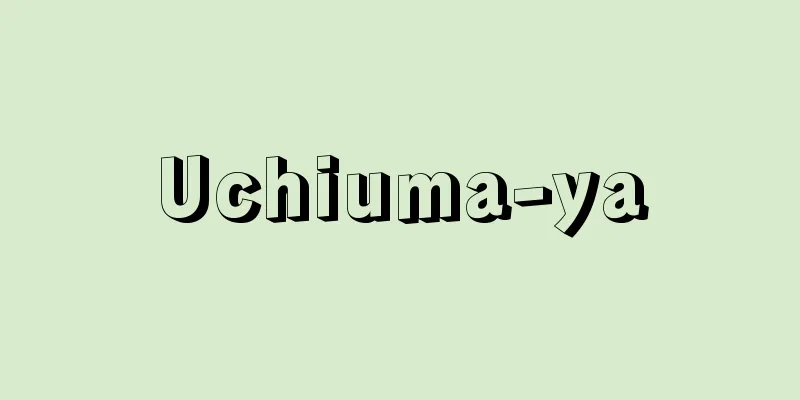Katsushika Hokusai

|
An ukiyo-e artist from the mid- to late Edo period. Born in Warigesui, Honjo, Edo, as the son of a certain Kawamura. Not much is known about his early life, but his childhood name was Tokitaro, which he later changed to Tetsuzo. It is said that he was briefly adopted by Nakajima Ise, a mirror maker for the shogunate, when he was around four or five years old, but the circumstances of that time are not known. It is said that he learned woodblock engraving at the age of fourteen or fifteen, and also became an apprentice at a book rental store, and later recalled that he had enjoyed drawing since he was around six years old. However, it is said that he did not enter the world of ukiyo-e in earnest until 1778 (An'ei 7), when he became a pupil of Katsukawa Shunsho, who was known at the time as a master of actor paintings. He made his debut in the art world as early as the following year, taking the character "ro" from Shunsho's pseudonym Kyokurosei and taking the name Katsukawa Shunro, and publishing two other illustrations at roughly the same time, including a thin-print actor picture entitled "Segawa Kikunojo's Masamune Daughter Oren." After this, he spent about 15 years as an artist of the Katsukawa school, illustrating nishikie (colored woodblock prints), kibyō (yellow cover illustrations), and sharebon (comic books), but in 1794 (Kansei 6), he left the Katsukawa school and took on the name Tawaraya Sōri of the Rinpa school, becoming active in the field by producing a large number of kyoka ehon (comic poetry picture books) and surimono (printed woodblock prints). Around this time, he also began writing comic stories, publishing several kibyō (yellow cover illustrations) under the name Tokitarō Kakō. However, in 1798 he returned the name Sori to his family, took on the pseudonym Hokusai and began his independent career as an artist. First, from around 1804 (Bunka 1) to around 1813, he left behind many masterpieces in the field of illustrations for reading books. Among them, "Shinpen Suiko Gaden" and "Chinsetsu Yumiharizuki" published in collaboration with Kyokutei Bakin, and "Kinsei Kaidan Shimoyo no Hoshi" published with Ryutei Tanehiko are well-known as representative reading books of this period. From around 1814, he rapidly decreased his illustrations for reading books, which had published several works every year, and instead he began to concentrate on picture manuals, which could be considered instructional books for drawing. The best known in this field is "Hokusai Manga," which continued to be published after his death from the same year. With over 3,000 illustrations throughout the entire series, it is a true encyclopedia of pictures, and has had a great influence not only in Japan but also in Europe since ancient times, where it has been called "Hokusai Sketch." Other picture manuals that introduce special drawing techniques, such as "Ryakuga Hayaooshie," "Santei Gafu," and "Ichibu Gafu," were also published in this field, and in 1848 (Kaei 1) "Ehon Saishikitsu" (Illustrated Book of Colors) showed how to create oil paintings, glass paintings, copperplate prints, and other works. Thus, Hokusai's illustrated books continued to be published throughout his later years, but during that time, from around the beginning of the Bunsei era (1818-1830) to the beginning of the Tenpo era (1830-1844), he published a series of landscape paintings such as Thirty-six Views of Mount Fuji (46 panels in total), A Tour of Waterfalls in Various Provinces (8 panels in total), and A View of Famous Bridges in Various Provinces (11 panels in total). After that, around 1834 (Tenpo 5), he gradually devoted himself to hand-painted paintings, but his numerous drawings of lions entitled Nisshinjoma, which he painted as a daily routine from around 1843, contain many fresh works that are unimaginable from the style of his later years. However, the indomitable Hokusai also fell ill and passed away on April 18, 1859, at Henshoin Temple in Shotencho, Asakusa. Hokusai is said to have had many eccentricities, moving house 93 times during his life and changing his artist name more than 20 times, some of his most well-known pen names being Gakyojin, Taito, Iitsu, Gakyorojin, and Manji. However, his life as an artist, which lasted for about 70 years, was permeated with hard work and study, and his passion was rare for an artist of his time. [Nagata Seiji] "Ukiyo-e Taikei 8 Hokusai" edited by Oka Isaburou (1975, Shueisha)" ▽ "Japanese Art 31 Hokusai" by Tsuji Tsuneo (1982, Shogakukan)" ▽ "Treasures of Japanese Art 23 Hokusai and Hiroshige" by Matsuki Hiroshi (1983, Shogakukan)" [Reference item] |National Diet Library Katsushika Hokusai "Thirty-six Views of Mount Fuji: Edo Nihonbashi" National Diet Library Hokusai Katsushika's Thirty-six Views of Mount Fuji: A View of Senju Red Light District... National Diet Library Katsushika Hokusai's "Famous Bridges of Various Provinces: Kameido Tenjin Shrine" National Diet Library Katsushika Hokusai "Famous Bridges of the Provinces: Tenmabashi Bridge in Setsu" National Diet Library Katsushika Hokusai "Hiratsuka: Fifty-three Stations of the Tokaido" National Diet Library Katsushika Hokusai "Shirasuka: Fifty-three Stations of the Tokaido" National Diet Library Katsushika Hokusai "New Woodblock Print: A Distant View of Shiba Atagoyama" National Diet Library Katsushika Hokusai "Kanadehon Chushingura, Act 11" Volume 1, Part 1, by Katsushika Hokusai, published in 1807 (Bunka 4), owned by the National Diet Library "Tsubakisetsu Yumiharizuki" (Frontispiece) Source: Shogakukan Encyclopedia Nipponica About Encyclopedia Nipponica Information | Legend |
|
江戸中期から後期にかけての浮世絵師。江戸・本所割下水(わりげすい)に川村某の子として生まれる。幼年時の事柄についてはあまり明らかではないが、幼名を時太郎といい、後年鉄蔵と改めた。4、5歳のころに一時、幕府御用鏡師中島伊勢(いせ)の養子となったといわれるが、その間の事情は伝わっていない。14、15歳のころ木板版下彫りを学び、また貸本屋の徒弟となったともいわれ、絵は6歳ごろから好んで描いていたと自ら後年に述懐している。しかし、本格的に浮世絵の世界に入ったのは、1778年(安永7)とされ、当時役者絵の大家として知られていた勝川春章(かつかわしゅんしょう)の門に入ってからである。 画界にデビューしたのは早くもその翌年で、春章の別号旭朗井(きょくろうせい)から朗の字をもらって勝川春朗と号し、細判(ほそばん)役者絵『瀬川菊之丞(きくのじょう)の正宗娘おれん』ほか2図をほぼ同時に発表している。この後、約15年間を勝川派の絵師として錦絵(にしきえ)や黄表紙、洒落本(しゃれぼん)などの挿絵を描いて過ごしたが、1794年(寛政6)中には勝川派を離れ、琳派(りんぱ)の俵屋宗理(たわらやそうり)を襲名して狂歌絵本や摺物(すりもの)などを数多く描いて活躍した。またこのころには戯作(げさく)も行い、時太郎可候(かこう)の名で数種の黄表紙を発表している。しかし、1798年には宗理号を家元に戻し、北斎を号して独立独歩の作画活動を開始することとなる。 まず1804年(文化1)ごろから1813年ごろにかけては読本(よみほん)挿絵の分野に多くの名作を残している。そのなかでもとくに、曲亭馬琴(きょくていばきん)とのコンビによって出版された『新編水滸(すいこ)画伝』や『椿説弓張月(ちんせつゆみはりづき)』、また柳亭種彦(りゅうていたねひこ)とによる『近世怪談霜夜星(しもよのほし)』などは、この時期の読本を代表するものとして著名である。1814年ごろより、連年数種の作品を発表してきた読本挿絵は急激に減少し、かわって絵の教習本ともいえる絵手本(えてほん)に傾注し始める。この方面でもっとも知られるのは、同年より没後も刊行され続けた『北斎漫画』である。全巻を通して約3000余図が載せられており、まさに絵の百科事典ともいえる性格をもっていて、日本はむろん、古くからヨーロッパにも「ホクサイスケッチ」とよばれ、多大な影響を及ぼしている。ほかにもこの方面では『略画早指南(りゃくがはやおしえ)』『三体画譜(さんていがふ)』『一筆画譜』など、特殊な描法を紹介した絵手本も発表されており、1848年(嘉永1)には『絵本彩色通(えほんさいしきつう)』で油彩画やガラス絵、銅版画などの制作方法を開陳している。このように絵手本は北斎晩年期に一貫して出版され続けたが、その間、文政(ぶんせい)(1818~1830)初年ごろから天保(てんぽう)(1830~1844)初年ごろにかけては、風景画の代表作『冨嶽(ふがく)三十六景』(全46枚)、『諸国滝廻(たきめぐ)り』(全8枚)、『諸国名橋奇覧』(全11枚)などのシリーズが集中的に出版されている。その後、1834年(天保5)ごろを境として、しだいに肉筆画に傾注するが、1843年ごろから日課として描いた『日新除魔(にっしんじょま)』と題されているおびただしい数の獅子(しし)の図には、老年期の画風とは思えぬみずみずしい作品が多数含まれていることに注目される。しかし、不屈の人北斎も病を得て嘉永(かえい)2年4月18日、浅草聖天町遍照院内に没した。 なお、北斎については多くの奇行が伝えられ、生涯のうち転居すること93回、また画号を改めること二十数度で、そのおもだった号だけでも画狂人(がきょうじん)、戴斗(たいと)、為一(いいつ)、画狂老人(がきょうろうじん)、卍(まんじ)など多くが知られている。しかし、約70年にも及んだ作画生活は終生刻苦勉学に貫かれていて、その情熱は当時の絵師としてはまれにみるところであった。 [永田生慈] 『岡畏三郎編『浮世絵大系8 北斎』(1975・集英社)』▽『辻惟雄著『日本の美術31 北斎』(1982・小学館)』▽『松木寛著『名宝日本の美術23 北斎・広重』(1983・小学館)』 [参照項目] |国立国会図書館所蔵"> 葛飾北斎『冨嶽三十六景 江戸日本橋』 国立国会図書館所蔵"> 葛飾北斎『冨嶽三十六景 従千住花街眺望… 国立国会図書館所蔵"> 葛飾北斎『諸国名橋奇覧 かめいど天神た… 国立国会図書館所蔵"> 葛飾北斎『諸国名橋奇覧 摂州天満橋』 国立国会図書館所蔵"> 葛飾北斎『東海道五十三次 平塚』 国立国会図書館所蔵"> 葛飾北斎『東海道五十三次 白須賀』 国立国会図書館所蔵"> 葛飾北斎『新板浮絵 芝愛宕山遠見之図』 国立国会図書館所蔵"> 葛飾北斎『仮名手本忠臣蔵 十一段』 前編 巻1 葛飾北斎画 1807年(文化4)刊国立国会図書館所蔵"> 『椿説弓張月』(口絵) 出典 小学館 日本大百科全書(ニッポニカ)日本大百科全書(ニッポニカ)について 情報 | 凡例 |
Recommend
Peppered Geometer moth (English name: Biston betularia)
A moth of the family Geometridae, order Lepidopter...
Kayo [town] - Kayo
A former town in Jobo District, central Okayama Pr...
Gérard - Gérard, Alfred
Year of death: 1915.3.15 (1915.3.15) Born: March 2...
Seven in Space - Seven in Space
...It won the Silver Lion at the Venice Film Fest...
Battle of Tourpoitiers - Battle of Tourpoitiers
In 732, Charles Martel, mayor of the Frankish king...
Quality control - hinshitsukanri (English spelling) quality control
Quality refers to the level of quality of the con...
Caquetoire (English spelling)
An armchair made in France in the late 16th centur...
Jacques Androuet du Cerceau
Around 1510-85 French Renaissance architect and ar...
Sylvilagus floridanus (English spelling) Sylvilagusfloridanus
…[Yoshiharu Imaizumi]. … *Some of the terminology...
Oya Yotsugi - Oya Yotsugi
…There are three, six and eight volumes of manusc...
The Soga Meeting - Soga no Taimen
In the Soga Kyogen (→ Sogamono), which is based on...
Kiyomihara Palace
…In 672 (Tenmu 1), after the end of the Jinshin W...
Nine-jo seal script
...Private seals and official seals took two oppo...
Clavariadelphus pistillaris (English spelling) Clavariadelphuspistillaris
...Although it is similar in shape to the broom m...
Manchu - Manshu-zoku (English spelling) Manchu
Also called Manchu. A group of people who speak a ...



![Fujisawa [town] - Fujisawa](/upload/images/67ccb27631fb8.webp)





